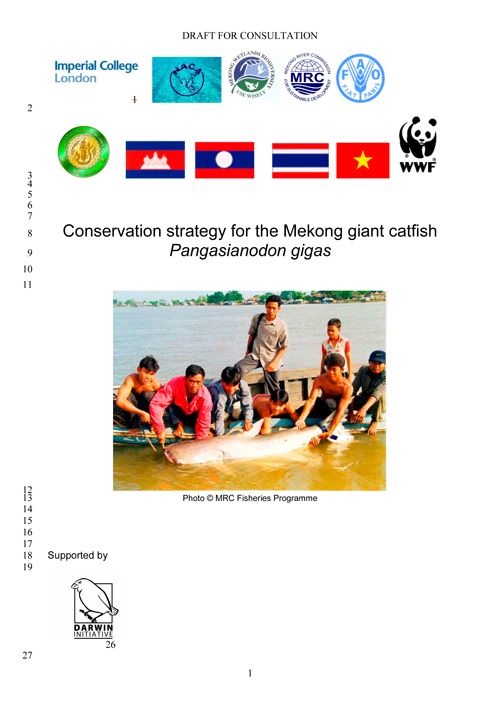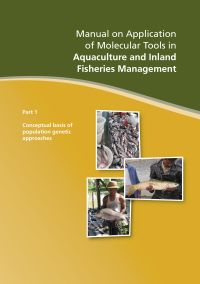Conservation strategy for the Mekong giant catfish Pangasianodon gigas: Draft for consultation
22 April 2008 | 2603 Downloads | .pdf | 976.15 KB | Cambodia, Freshwater prawns, Genetics and Biodiversity, Lao PDR, Thailand, Vietnam
This is a draft conservation strategy for the Mekong giant catfish prepared under the project Development of a conservation strategy for the critically endangered Mekong giant catfish, released for public consultation.
Species and importance: The Mekong giant catfish (MGC) Pangasianodon gigas is one of the world's largest freshwater fish. A charismatic animal revered throughout the lower Mekong region, the species is of great cultural importance. It is also widely recognised as an indicator of ecological integrity of the Mekong ecosystem, due to its long-distance migrations, size and longevity. Owing to its rarity, the species does not contribute significantly to the Mekong fisheries catch in biomass or value (but is highly sensitive to fishing). The species is herbivorous and unlikely to exert an important influence on ecosystem structure or functioning. The species is listed as critically endangered in the 2003 IUCN Red List.
Legal status: The species is protected by national law in Cambodia (where it must be released if caught in fisheries) and in Thailand (where fishing for the giant catfish is prohibited, but special permission can be granted by the Department of Fisheries). In the Lao PDR, no specific legal protection exists for the species, but it is protected alongside other aquatic resources by the general provisions of the environment law, water resources law and forestry law. In Vietnam, the species is listed in the Red Book and thus afforded special legal protection.
Population status: The species appears to be naturally rare, and is likely to have maintained a small but stable population throughout much of the 20th 101 century. Reconstructed spawner abundance was relatively stable at about 250 animals prior to 1983 (11-71% of unexploited abundance). The population then declined dramatically to just 50 spawners in 1995 (2-14% of unexploited abundance). The Chiang Khong fishing 'boom' thus reduced spawner abundance by about 80% in just ten years. The population has since recovered to about 145 animals (7-40% of unexploited abundance) by 2006. Much of this predicted recovery is based on maturation of fish that were spawned about 20 years previously, and would occur even if for any reason reproduction had failed in the recent past. Spawner abundance in the absence of fishing has been estimated at 355-2200 animals.
Conservation vision and goals: The core conservation vision or goal of the Mekong Giant Catfish Conservation Group is the maintenance of a viable wild population of Mekong giant catfish and the restoration of its historical distribution. Maintenance of a genetically representative captive population is crucial as 'insurance' against possible (if not likely) extinction in the wild. Maintenance of critical habitats and ecosystem processes in the Mekong basin is clearly important if a wild population is to be maintained. The presumed transboundary migrations and reliance on a variety of habitats of the MGC make it an ideal flagship species for ecosystem conservation in the Mekong. In this context, maintenance of the MGC's social and cultural importance is in itself a goal of conservation initiatives.
Factors affecting the population: Habitat and environmental change in the Mekong basin has been gradual and of moderate magnitude until the very recent past, and it is unlikely that this has been a significant factor in past population change. More dramatic changes may have occurred in the very recent past. Recent 'rapid blasting' and the commissioning of several dams in the upper river may have affected physical habitat structure, and increasingly affect flow patterns and water levels in the future. Fishing can be identified as the main driver of past changes in population abundance and structure. The exceptionally intensive Chiang Khong fishery in the 1980s and 90s in particular is likely to account for the dramatic population decline observed over this period. Interactions with other species, either native or non-native, are unlikely to have played a significant role in past population change, and there are no known issues in this regard for the future. Interactions with cultured fish are unlikely to have played a significant role in past population change, but may become a major issue in the future due to both intentional and accidental releases. At present the cultured population is likely to exceed the wild population in abundance.
Conservation strategy: Fishing. Fishing mortality on the recruited population should be maintained at very low levels. For the next two decades, catches should not exceed 10 mature fish per year in order to allow some population recovery. The legal mechanisms for harvest regulation are in place in Cambodia and Thailand, but need to be strengthened in the Lao PDR. Habitat conservation. Maintaining the overall Mekong ecosystem (flows, physical habitats and connectivity) clearly is important to ensuring the long-term survival of the species in the wild. Given that habitat use and migration patterns of the species are largely unknown, no essential habitat can be identified except for the spawning area. The spawning area is very likely to be located within some 50 miles north of Chiang Khong, and it can be clearly identified as essential habitat. An immediate priority should be to protect this habitat. There have been some suggestions that a second spawning area may be located neat the Cambodian town of Stung Treng, but this has not been confirmed by direct observations. Captive breeding. The captive population of MGC maintained by the Thai Department of Fisheries provides a vital 'insurance', safeguarding the survival of the species should it become extinct in the wild. The captive population should be managed carefully so as to conserve its genetic diversity, should re-introduction become necessary. For the time being, captive-bred fish should not (or only in very low numbers) be released into the Mekong or its tributaries because the wild population is likely to recover naturally. Releases would have no net benefit but could compromise this process through ecological and genetic interactions with captive bred fish. Aquaculture. Escapes of MGC grown in commercial aquaculture could pose a significant threat to the wild population. Measures should be taken to minimise the risk of such escapes occurring. It should be noted that, because the wild population carrying capacity appears to be quite low, releases of even low numbers of captive-bred fish can have significant impacts on the wild population.
Monitoring, research and adaptive management: Monitoring should encompass factors affecting the wild population, the status of the wild population, and the status of the captive population. Monitoring of factors affecting the population is particularly important because it will allow identifying and alleviating risks well before population impacts would become measurable. Monitoring of the population itself is possible only on the basis of fisheries data from traditional targeted and incidental fisheries (principally in Chiang Khong and the Tonle Sap River, respectively). There is thus a tradeoff between minimising harvest and maximising monitoring information, but maintenance of a low level of traditional harvesting is deemed not to pose a great risk to the population. Monitoring of the captive population should cover its demography and breeding practice in relation to the genetic management plan. Further molecular genetic analysis will be required approximately every 5 years in order to extend the breeding plan to newly maturing fish. Further research is required on habitat use and movement of wild and released captive-bred fish with a view to identifying key habitats and supporting a re-introduction programme should this become necessary. Adaptive management entails responding to new monitoring information in a way that promotes long-term persistence of the wild population.
Implementation: The strategy will be implemented by multiple institutions. The MRC Technical Advisory Board for Fisheries (MRC-TAB) will assume a coordinating function and conduct annual reviews and assessments of monitoring information. The Royal Cambodian Fisheries Administration will continue to restrict harvesting of the giant catfish and minimise its incidental capture. The Lao Department of Livestock and Fisheries, and LARReC will strive to increase legal protection of the species from unsustainable harvesting. The Royal Thai Department of Fisheries will maintain its captive population of giant catfish and apply improved breeding protocols based on molecular genetic analysis. It will also continue to regulate the harvest of giant catfish with a view to conserving the wild population while also providing population monitoring data and maintaining the indicator value of the species.
Creative Commons Attribution.

